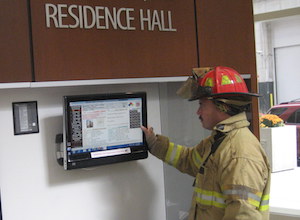
The older adults at assisted living communities are the most vulnerable in emergency situations. And just as the day-to-day care you give them is carefully planned out, so, too, should be the second-to-second plan in cases of emergency.
Excellent response is never an accident. To ensure that first responders are in the best position to save lives and property, the tools for success need to be in place well in advance. As managers and guardians of staff and residents, all assisted living property managers must fulfill the crucial responsibility of pre-incident planning their facilities.
The National Fire Protection Association has outlined pre-plan standards for fire departments to evaluate protection systems, building construction, contents and operating procedures. As the most important on-site points of contact in case of an emergency, property and facility managers should take proactive steps to play an active role in ensuring the first responders are as informed and prepared as possible. Here’s how:
- Share your information. The number one way to have an effective pre-plan is through interoperable data. By sharing highly detailed property information, you ensure that local responders have easy access to the latest building and occupant characteristics. Make it digital and find a program, such as CommandScope, that will allow for easy real-time updates.
- Think beyond fire. Consider the broadest range of emergency situations that your occupants and visitors may face. Could it be a fire? Sure. But what about an active shooter, terrorism, hazardous material emergency, earthquake, flooding or even a simple power outage? Always hope for the best and prepare for the worst.
- Think of everyone in the building. Who are your users? Who are the most vulnerable? Who are your special needs visitors? Are there any disabled or sick? When are the high-visitation days and hours that might mean children are present?
- Conduct regular drills. Put your pre-plan to the test and invite local fire and police first responders to participate in varied situations and scenarios. Those training sessions will highlight information gaps in your drills and strengthen your ability to provide the right support to those putting their lives on the line.
- Exits, exits…exit? Some situations will call for building evacuations — no easy exercise in assisted living facilities. Many situations require stay-in-place procedures, however. Be aware of both. Ensure that those in the building understand both. Make sure your pre-plan includes site plans and floor plans that visually identify where those stay-in-place locations and exits are.
 A first-response emergency occurs in the United States every 23 seconds, according to NFPA. As much as we ask of our first responders, it is every property manager’s obligation to effectively minimize risk and make all tools available for use.
A first-response emergency occurs in the United States every 23 seconds, according to NFPA. As much as we ask of our first responders, it is every property manager’s obligation to effectively minimize risk and make all tools available for use.
Many people are not aware that most emergency response departments respond via “mutual aid” agreements, meaning the majority of the first responders never have stepped foot in your assisted living community before your 911 call. Your digital pre-plan will minimize the guess work no matter who is on site, allowing first responders to act with knowledge.
Stephen Nardi is the CEO of RealView LLC, developers of the CommandScope all digital pre-plan technology. For more information, visit www.realviewllc.com.




